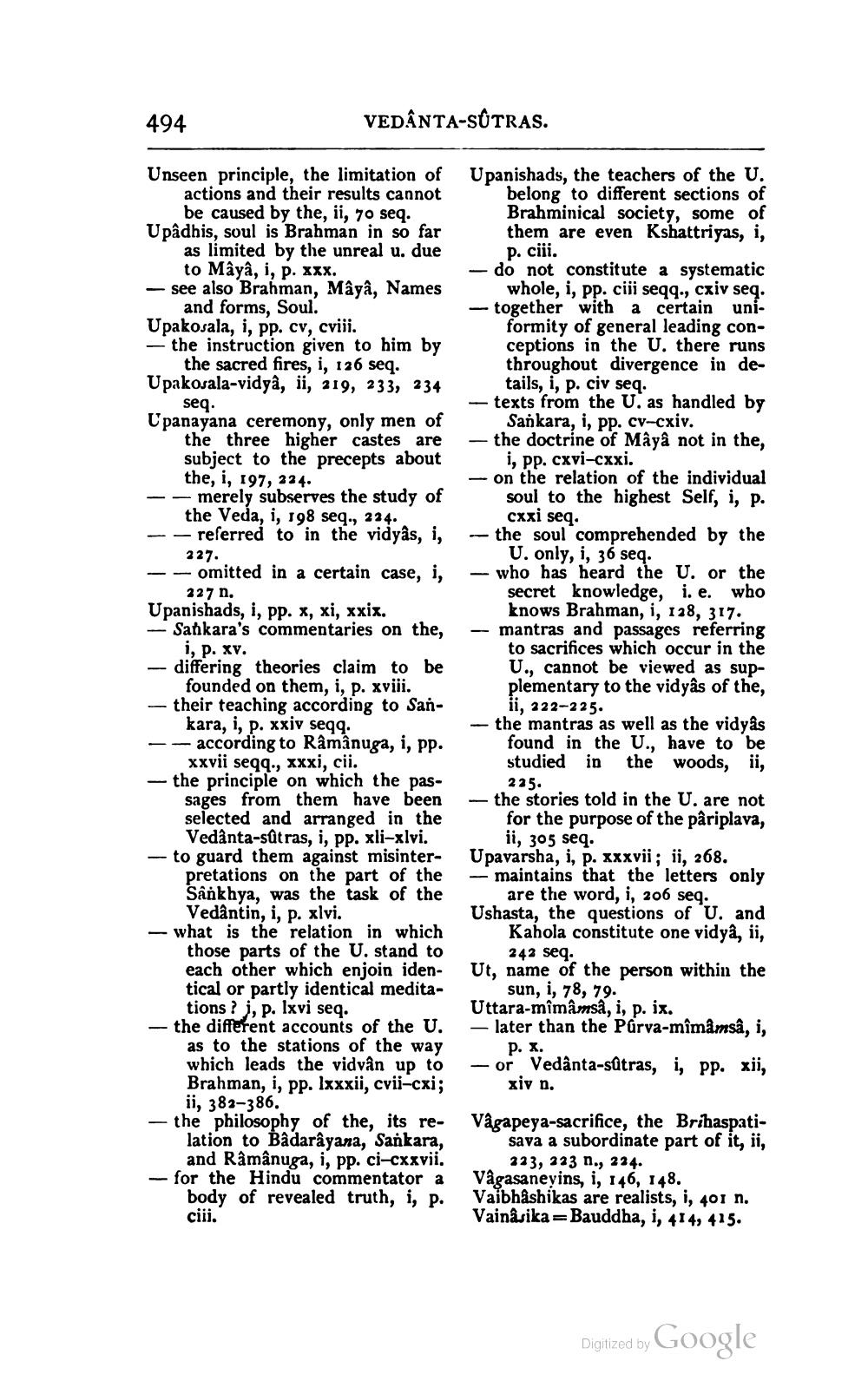________________
494
VEDÂNTA-SÛTRAS.
Unseen principle, the limitation of
actions and their results cannot
be caused by the, ii, 70 seq. Upâdhis, soul is Brahman in so far
as limited by the unreal u. due
to Mâyâ, i, p. xxx. - see also Brahman, Mâyâ, Names
and forms, Soul. Upakosala, i, pp. cv, cviji. - the instruction given to him by
the sacred fires, i, 126 seq. Upakosala-vidyâ, ii, 219, 233, 234
seq. Upanayana ceremony, only men of
the three higher castes are subject to the precepts about
the, i, 197, 324. -- merely subserves the study of
the Veda, i, 198 seq., 234. -- referred to in the vidyâs, i,
227. -- omitted in a certain case, i,
227 n. Upanishads, i, pp. x, xi, xxix. - Sankara's commentaries on the,
i, p. xv. - differing theories claim to be
founded on them, i, p. xviii. - their teaching according to San
kara, i, p. xxiv seqq. --according to Râmânuga, i, pp.
xxvii seqq., xxxi, cii. - the principle on which the pas
sages from them have been selected and arranged in the
Vedanta-sût ras, i, pp. xli-xlvi. - to guard them against misinter-
pretations on the part of the Sankhya, was the task of the
Vedântin, i, p. xlvi. - what is the relation in which
those parts of the U. stand to each other which enjoin identical or partly identical medita
tions? i, p. lxvi seq. - the different accounts of the U.
as to the stations of the way which leads the vidvân up to Brahman, i, pp. Ixxxii, cvii-cxi;
ii, 383–386. - the philosophy of the, its re-
lation to Badarayana, Sankara,
and Râmânuga, i, pp. ci-cxxvii. - for the Hindu commentator a
body of revealed truth, i, p. ciii.
Upanishads, the teachers of the U.
belong to different sections of Brahminical society, some of them are even Kshattriyas, i,
p. ciji. - do not constitute a systematic
whole, i, pp. ciji seqq., cxiv seq. - together with a certain uni
formity of general leading conceptions in the U. there runs throughout divergence in de
tails, i, p. civ seq. - texts from the U. as handled by
Sankara, i, pp. cv-cxiv. - the doctrine of Mâyâ not in the,
i, pp. cxvi-cxxi. - on the relation of the individual
soul to the highest Self, i, p.
cxxi seq. - the soul comprehended by the
U. only, i, 36 seq. - who has heard the U. or the
secret knowledge, i. e. who
knows Brahman, i, 128, 317. -- mantras and passages referring
to sacrifices which occur in the U., cannot be viewed as supplementary to the vidyâs of the,
ii, 222-225. - the mantras as well as the vidyas
found in the U., have to be studied in the woods, ii,
225. - the stories told in the U. are not
for the purpose of the pâriplava,
ii, 305 seq. Upavarsha, i, p. xxxvii; ii, 268. - maintains that the letters only
are the word, i, 206 seg. Ushasta, the questions of U. and
Kahola constitute one vidyâ, ii,
242 seq. Ut, name of the person within the
sun, i, 78, 79. Uttara-mîmâmsa, i, p. ix. – later than the Purva-mîmåmsa, i,
P. X. – or Vedanta-sûtras, i, pp. xii,
xiv n.
Vâgapeya-sacrifice, the Brihaspati
sava a subordinate part of it, ii,
223, 223 n., 214. Vagasaneyins, i, 146, 148. Vaibhashikas are realists, i, 401 n. Vainasika = Bauddha, i, 414, 415.
Digized by Google




